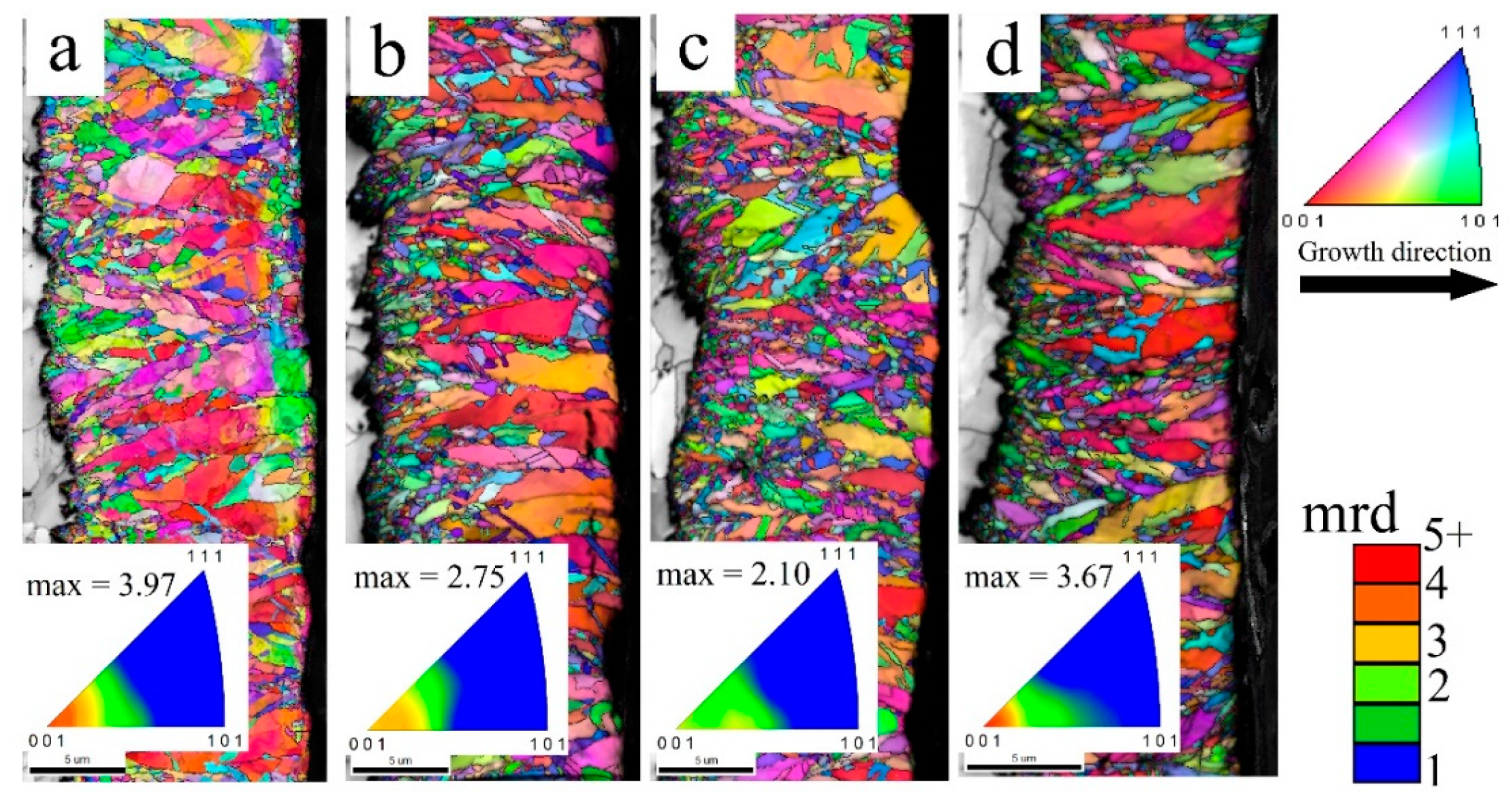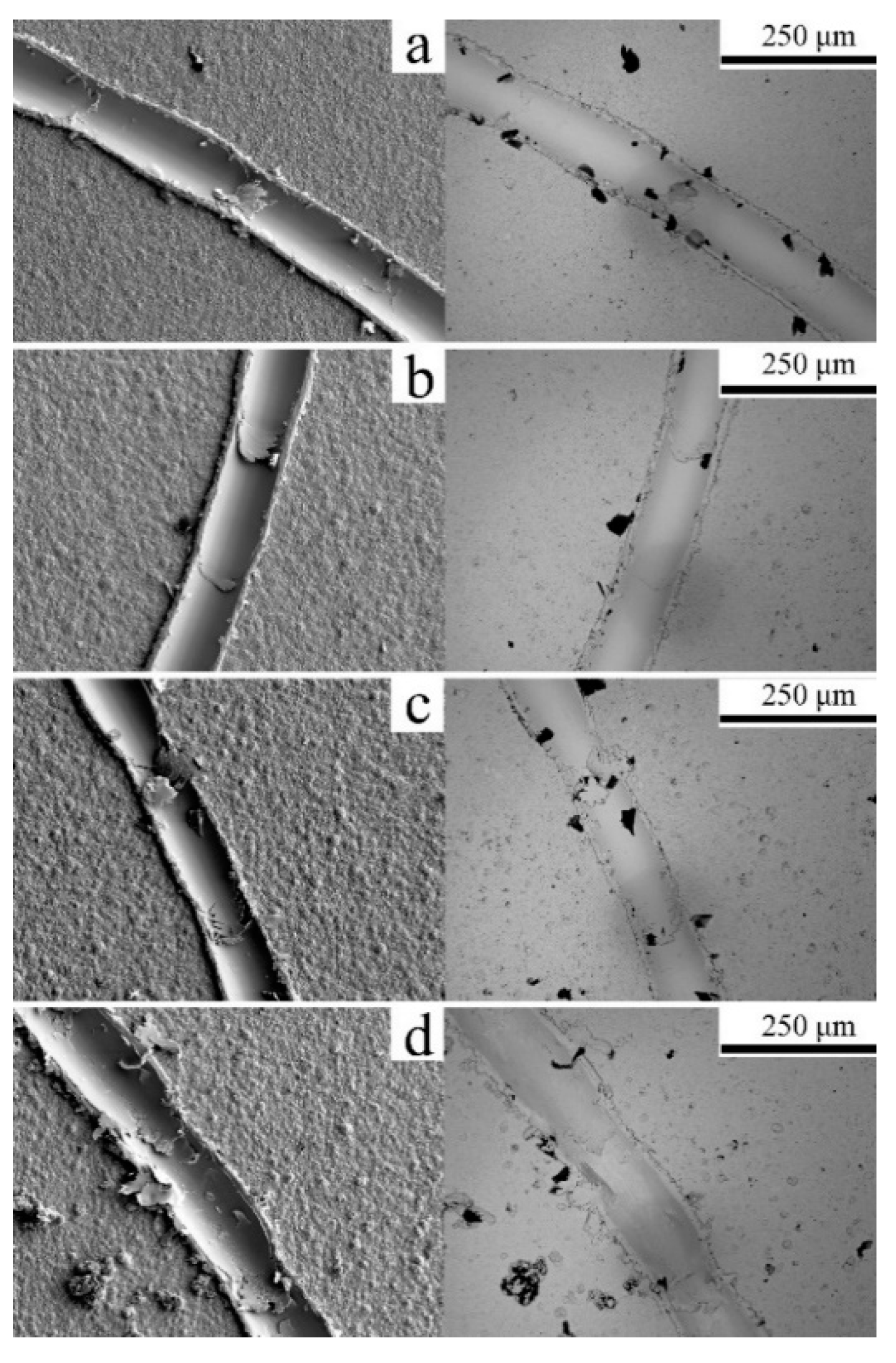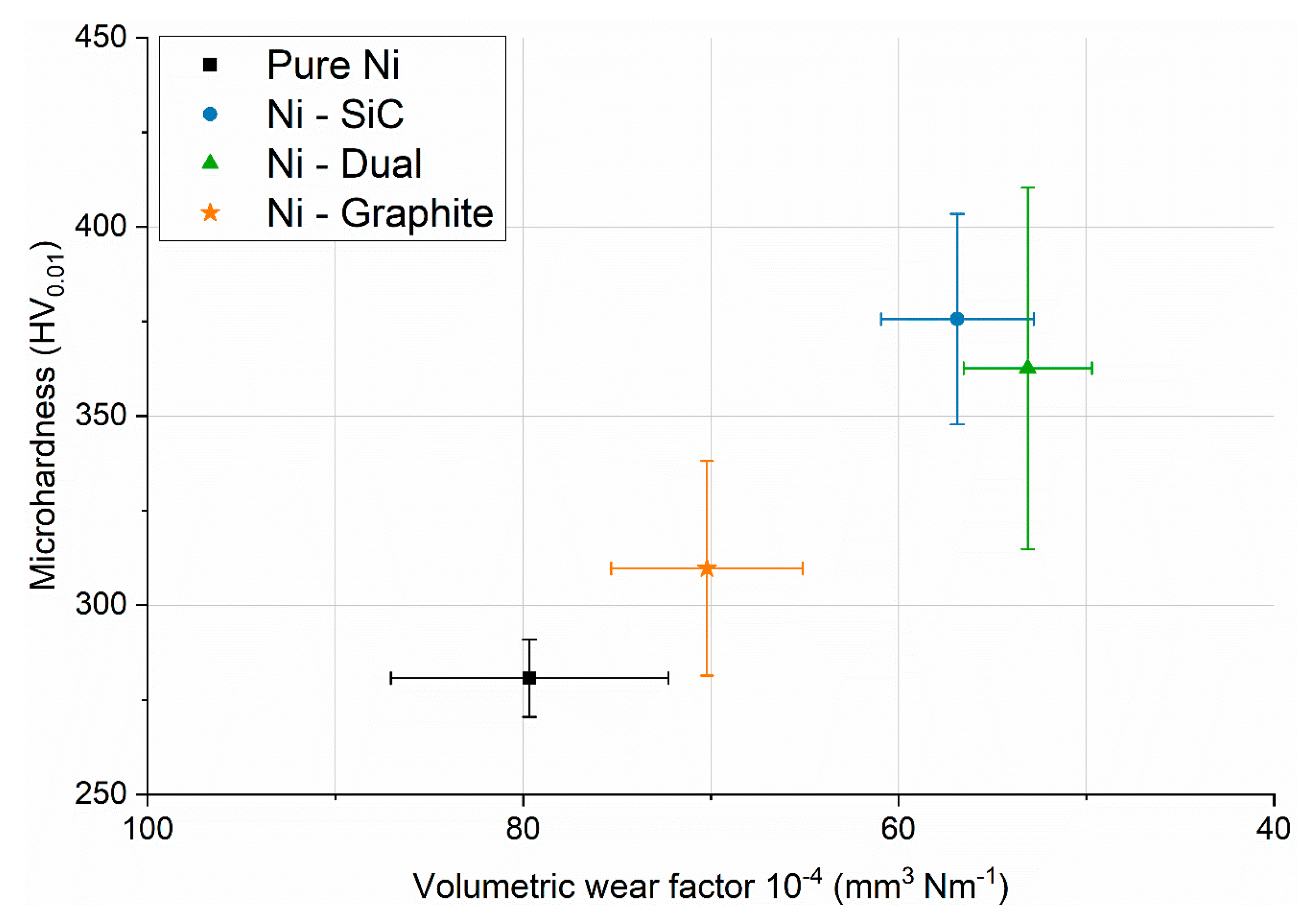Wear Behavior of Ni-Based Composite Coatings with Dual Nano-SiC: Graphite Powder Mix
Abstract
:1. Introduction
2. Materials and Methods
2.1. Electrolyte Composition and Experimental Setup
2.2. Coating Characterization
3. Results and Discussion
3.1. Coatings’ Electrodeposition
3.2. Surface Morphology and Microstructure
3.3. Microhardness
3.4. Tribological Study
4. Conclusions
Author Contributions
Funding
Conflicts of Interest
References
- Lekka, M.; Zanella, C.; Klorikowska, A.; Bonora, P.L. Scaling-up of the electrodeposition process of nanocomposite coating for corrosion and wear protection. Electrochim. Acta 2010, 55, 7876–7883. [Google Scholar] [CrossRef]
- Gyftou, P.; Pavlatou, E.A.; Spyrellis, N.; Hatzilyberis, K.S. Nickel matrix composite coatings: Application in textile machinery and evaluation of cotton products quality. Trans. IMF 2000, 78, 223–226. [Google Scholar] [CrossRef]
- Walsh, F.C.; Wang, S.; Zhou, N. The electrodeposition of composite coatings: Diversity, applications and challenges. Curr. Opin. Electrochem. 2020, 20, 8–19. [Google Scholar] [CrossRef]
- Donnet, C.; Erdemir, A. Historical developments and new trends in tribological and solid lubricant coatings. Surf. Coat. Technol. 2004, 180–181, 76–84. [Google Scholar] [CrossRef]
- Walsh, F.C.; Ponce de Leon, C. A review of the electrodeposition of metal matrix composite coatings by inclusion of particles in a metal layer: An established and diversifying technology. Trans. IMF 2014, 92, 83–98. [Google Scholar] [CrossRef] [Green Version]
- Kerr, C.; Barker, D.; Walsh, F.; Archer, J. The electrodeposition of composite coatings based on metal matrix-included particle deposits. Trans. IMF 2000, 78, 171–178. [Google Scholar] [CrossRef]
- Ortolani, M.; Zanella, C.; Azanza Ricardo, C.L.; Scardi, P. Elastic grain interaction in electrodeposited nanocomposite Nickel matrix coatings. Surf. Coat. Technol. 2012, 206, 2499–2505. [Google Scholar] [CrossRef]
- Lampke, T.; Wielage, B.; Dietrich, D.; Leopold, A. Details of crystalline growth in co-deposited electroplated nickel films with hard (nano)particles. Appl. Surf. Sci. 2006, 253, 2399–2408. [Google Scholar] [CrossRef]
- Zanella, C.; Lekka, M.; Bonora, P.L. Influence of the particle size on the mechanical and electrochemical behaviour of micro- and nano-nickel matrix composite coatings. J. Appl. Electrochem. 2009, 39, 31–38. [Google Scholar] [CrossRef]
- Góral, A. Nanoscale structural defects in electrodeposited Ni/Al2O3 composite coatings. Surf. Coat. Technol. 2017, 319, 23–32. [Google Scholar] [CrossRef]
- Borkar, T.; Harimkar, S.P. Effect of electrodeposition conditions and reinforcement content on microstructure and tribological properties of nickel composite coatings. Surf. Coat. Technol. 2011, 205, 4124–4134. [Google Scholar] [CrossRef]
- Gyftou, P.; Pavlatou, E.A.; Spyrellis, N. Effect of pulse electrodeposition parameters on the properties of Ni/nano-SiC composites. Appl. Surf. Sci. 2008, 254, 5910–5916. [Google Scholar] [CrossRef]
- Denise, F.; Leidheiser, H. An X-ray study of the effect of organic compounds on the crystal growth of nickel during electrodeposition. J. Electrochem. Soc. 1953, 100, 490–495. [Google Scholar] [CrossRef]
- Holmberg, K.; Ronkainen, H.; Laukkanen, A.; Wallin, K. Friction and wear of coated surfaces—scales, modelling and simulation of tribomechanisms. Surf. Coat. Technol. 2007, 202, 1034–1049. [Google Scholar] [CrossRef]
- Mahidashti, Z.; Aliofkhazraei, M.; Lotfi, N. Review of nickel-based electrodeposited tribo-coatings. Trans. Indian Inst. Met. 2018, 71, 257–295. [Google Scholar] [CrossRef]
- Rostami, M.; Fahami, A.; Nasiri-Tabrizi, B.; Ebrahimi-Kahrizsangi, R.; Saatchi, A. Characterization of electrodeposited Ni–SiC–Cg nanocomposite coating. Appl. Surf. Sci. 2013, 265, 369–374. [Google Scholar] [CrossRef]
- Lapinski, J.; Pletcher, D.; Walsh, F.C. The electrodeposition of nickel–graphite composite layers. Surf. Coat. Technol. 2011, 205, 5205–5209. [Google Scholar] [CrossRef]
- Watts, O.P. Rapid nickel plating. Trans. Am. Electrochem. Soc. 1916, 29, 395–403. [Google Scholar] [CrossRef]
- Amblard, J.; Epelboin, I.; Froment, M.; Maurin, G. Inhibition and nickel electrocrystallization. J. Appl. Electrochem. 1979, 9, 233–242. [Google Scholar] [CrossRef]
- Crouch, P.C.; Hendricksen, H.V. Current efficiency on Watts baths. Trans. IMF 1983, 61, 133–140. [Google Scholar] [CrossRef]
- Alizadeh, M.; Mirak, M.; Salahinejad, E.; Ghaffari, M.; Amini, R.; Roosta, A. Structural characterisation of electro-codeposited Ni–Al2O3–SiC nanocomposite coatings. J. Alloy. Compd. 2014, 611, 161–166. [Google Scholar] [CrossRef]
- Garcia, I.; Fransaer, J.; Celis, J.P. Electrodeposition and sliding wear resistance of nickel composite coatings containing micron and submicron SiC particles. Surf. Coat. Technol. 2001, 148, 171–178. [Google Scholar] [CrossRef]
- Nowak, P.; Socha, R.P.; Kaisheva, M.; Fransaer, J.; Celis, J.-P.; Stoinov, Z. Electrochemical investigation of the codeposition of SiC and SiO2 particles with nickel. J. Appl. Electrochem. 2000, 30, 429–437. [Google Scholar] [CrossRef]
- Hou, K.; Ger, M.; Wang, L.; Ke, S. The wear behaviour of electro-codeposited Ni–SiC composites. Wear 2002, 253, 994–1003. [Google Scholar] [CrossRef]
- Gül, H.; Kılıç, F.; Uysal, M.; Aslan, S.; Alp, A.; Akbulut, H. Effect of particle concentration on the structure and tribological properties of submicron particle SiC reinforced Ni metal matrix composite (MMC) coatings produced by electrodeposition. Appl. Surf. Sci. 2012, 258, 4260–4267. [Google Scholar] [CrossRef]
- Low, C.T.J.; Wills, R.G.A.; Walsh, F.C. Electrodeposition of composite coatings containing nanoparticles in a metal deposit. Surf. Coat. Technol. 2006, 201, 371–383. [Google Scholar] [CrossRef]
- Lanzutti, A.; Lekka, M.; De Leitenburg, C.; Fedrizzi, L. Effect of pulse current on wear behavior of Ni matrix micro-and nano-SiC composite coatings at room and elevated temperature. Tribol. Int. 2019, 132, 50–61. [Google Scholar] [CrossRef]
- Pinate, S.; Leisner, P.; Zanella, C. Electrocodeposition of nano-SiC particles by pulse-reverse under an adapted waveform. J. Electrochem. Soc. 2019, 166, D804–D809. [Google Scholar] [CrossRef]
- Vaezi, M.R.; Sadrnezhaad, S.K.; Nikzad, L. Electrodeposition of Ni–SiC nanocomposite coatings and evaluation of wear and corrosion resistance and electroplating characteristics. Colloids Surf. A 2008, 315, 176–182. [Google Scholar] [CrossRef]
- Berman, A.D.; Ducker, W.A.; Israelachvili, J.N. Experimental and theoretical investigations of stick-slip friction mechanisms. In Physics of Sliding Friction; Persson, B.N.J., Tosatti, E., Eds.; Springer: Dordrecht, The Netherlands, 1996; pp. 51–67. ISBN 978-90-481-4674-1. [Google Scholar]
- Gyftou, P.; Stroumbouli, M.; Pavlatou, E.A.; Asimidis, P.; Spyrellis, N. Tribological study of Ni matrix composite coatings containing nano and micro SiC particles. Electrochim. Acta 2005, 50, 4544–4550. [Google Scholar] [CrossRef]
- Kato, K. Abrasive wear of metals. Tribol. Int. 1997, 30, 333–338. [Google Scholar] [CrossRef]








| Bath Compositions | g L−1 | Parameters | |
|---|---|---|---|
| NiSO4·7H2O (Sigma-Aldrich) | 240 | pH | 3.00 |
| NiCl2·6H2O (Sigma-Aldrich) | 45 | Temperature | 45 °C |
| H3BO3 (J.T. Baker) | 30 | Stirring | 200 rpm |
| Particle load | 10; 10:10 | Current density | 4 A dm−2 |
| - | - | Deposition time | 30 min |
| Particle Content | SiC | Dual | Graphite | |
|---|---|---|---|---|
| SiC | Graphite | |||
| Vol% | 1.58 ± 0.48 | 1.45 ± 0.51 | 5.32 ± 1.50 | 3.99 ± 0.48 |
| Wt% | 0.58 ± 0.18 | 0.55 ± 0.20 | 1.41 ± 0.42 | 1.03 ± 0.13 |
| Sample | Pure Ni | Ni-SiC | Ni-Dual | Ni-Graphite |
|---|---|---|---|---|
| Grain area | 8.14 ± 0.33 | 6.55 ± 0.41 | 6.42 ± 0.30 | 7.86 ± 0.40 |
| Track Profile | Pure Ni | Ni-SiC | Ni-Dual | Ni-Graphite |
|---|---|---|---|---|
| Width | 95.18 ± 4.42 | 89.91 ± 3.99 | 89.49 ± 2.34 | 92.14 ± 3.19 |
| Depth | 12.35 ± 0.78 | 9.88 ± 0.56 | 9.37 ± 0.41 | 11.20 ± 0.39 |
Publisher’s Note: MDPI stays neutral with regard to jurisdictional claims in published maps and institutional affiliations. |
© 2020 by the authors. Licensee MDPI, Basel, Switzerland. This article is an open access article distributed under the terms and conditions of the Creative Commons Attribution (CC BY) license (http://creativecommons.org/licenses/by/4.0/).
Share and Cite
Pinate, S.; Zanella, C. Wear Behavior of Ni-Based Composite Coatings with Dual Nano-SiC: Graphite Powder Mix. Coatings 2020, 10, 1060. https://doi.org/10.3390/coatings10111060
Pinate S, Zanella C. Wear Behavior of Ni-Based Composite Coatings with Dual Nano-SiC: Graphite Powder Mix. Coatings. 2020; 10(11):1060. https://doi.org/10.3390/coatings10111060
Chicago/Turabian StylePinate, Santiago, and Caterina Zanella. 2020. "Wear Behavior of Ni-Based Composite Coatings with Dual Nano-SiC: Graphite Powder Mix" Coatings 10, no. 11: 1060. https://doi.org/10.3390/coatings10111060






